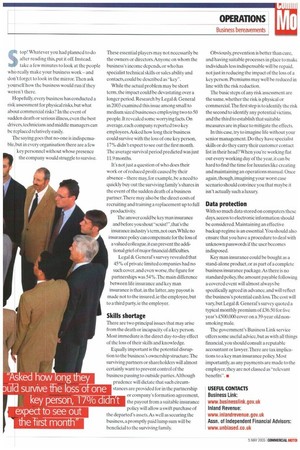NI SSING YOU ALREADY.. • 1
Page 56

Page 57

If you've noticed an error in this article please click here to report it so we can fix it.
Stop! Whatever you had planned to do after reading this, put it oft Instead, take a few minutes to look at the people who really make your business work — and don't forget to look in the mirror. Then ask yourself how the business would run if they weren't there.
Hopefully, every business has conducted a risk assessment for physical risks, but what about commercial risks? In the event of sudden death or serious illness, even the best drivers, technicians and middle managers can be replaced relatively easily.
The saying goes that no-one is indispensable,but in every organisation there are a few key personnel without whose presence the company would struggle to survive. These essential players may not necessarily be the owners or directors.Anyone on whom the business's income depends, or who has specialist technical skills or sales ability and contacts, could be described as "key".
While the actual problem may be short term, the impact could be devastating over a longer period. Research by Legal & General in 2003 examined this issue among small to medium sized businesses employing two to 50 people. It revealed some worrying facts. On average, each company reported two key employees. Asked how long their business could survive with the loss of one key person, 17% didn't expect to see out the first month. The average survival period predicted was just 11.9 months.
It's not just a question of who does their work or of reduced profit caused by their absence — there may, for example, be a need to quickly buy out the surviving family's shares in the event of the sudden death of a business partner.There may also be the direct costs of recruiting and training a replacement up to full productivity.
The answer could be key man insurance and before you shout "sexist!",that's the insurance industry's term, not ours While no insurance policy can compensate for the loss of a valued colleague. it can prevent the additional grief of major financial difficulties Legal & General's survey revealed that 45% of private limited companies had no such cover, and even worse, the figure for partnerships was 54 %.The main difference between life insurance and key man insurance is that, in the latter, any payout is made not to the insured, ie the employee, but to a third party, ie the employer.
Skills shortage
There are two principal issues that may arise from the death or incapacity of a key person. Most immediate is the direct day-to-day effect of the loss of their skills and knowledge.
Equally important is the potential disnipti on to the business's ownership structure.The surviving partners or shareholders will almost certainly want to prevent control of the business passing to outside parties. Although prudence will dictate that such circumstances are provided for in the partnership or company's formation agreement, the payout from a suitable insurance policy will allow a swift purchase of the departed's assets. As well as securing the business, a promptly paid lump sum will be beneficial to the surviving family. Obviously, prevention is better than cure, and having suitable processes in place to make individuals less indispensable will be repaid, not just in reducing the impact of the loss of a key person. Premiums may well be reduced in line with the risk reduction.
The basic steps of any risk assessment are the same. whether the risk is physical or commercial.The first step is to identify the risk the second to identify any potential victims, and the third to establish that suitable measures are in place to mitigate the effects.
In this case, try to imagine life without your senior management. Do they have specialist skills or do they carry their customer contact list in their head? When you're working flat out every working day of the year, it can be hard to find the time for luxuries like creating and maintaining an operations manual. Once again, though, imagining your worst case scenario should convince you that maybe it isn't actually such a luxury.
Data protection
With so much data stored on computers these days, access to electronic information should be considered. Maintaining an effective backup regime is an essential.You should also ensure that you have a procedure to deal with unknown passwords if the user becomes indisposed.
Key man insurance could be bought as a stand-alone product, or as part of a complete business insurance pack age.As there is no standard policy, the amount payable following a covered event will almost always be specifically agreed in advance, and will reflect the business's potential cash loss. The cost will vary, but Legal & General's survey quoted a typical monthly premium of £36.50 for five year's £500,000 cover on a 39-year old nonsmoking male.
The government's Business Link service offers some useful advice, but as with all things financial, you should consult a reputable accountant or lawyer.There are tax implications to a key man insurance policy. Most importantly, as any payments are made to the employer, they are not classed as "relevant benefits". •






































































































































































































